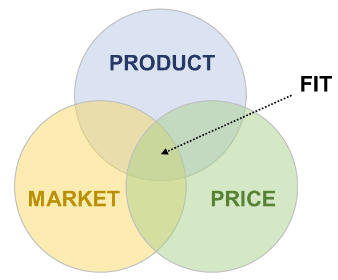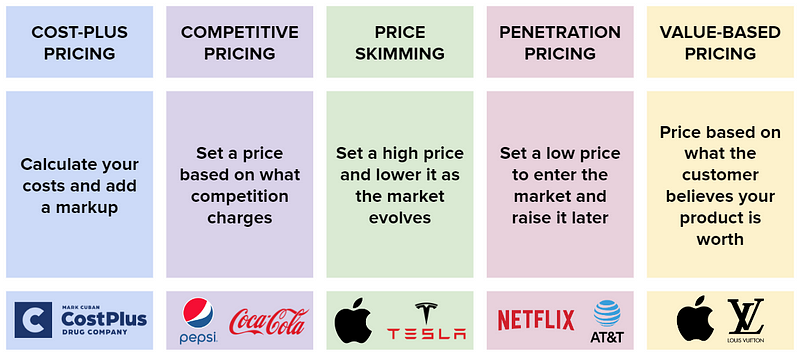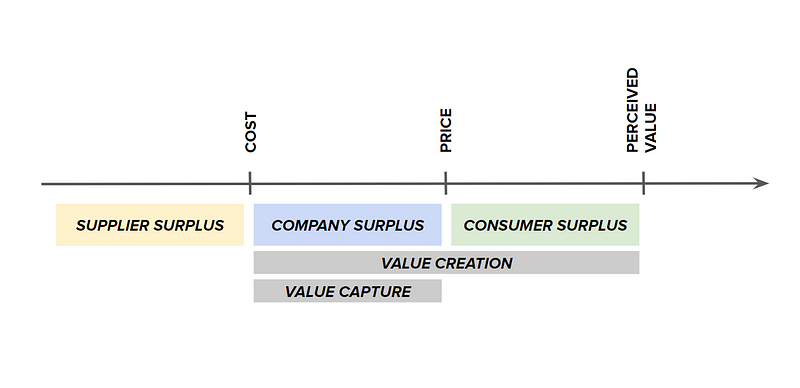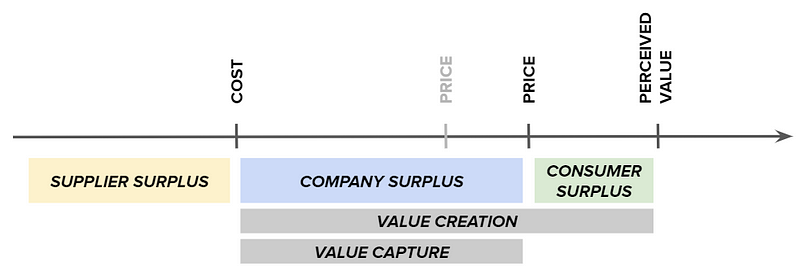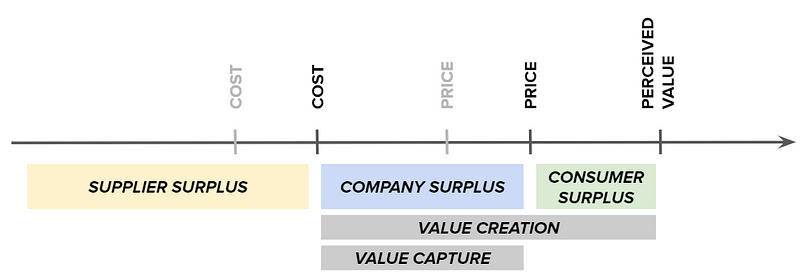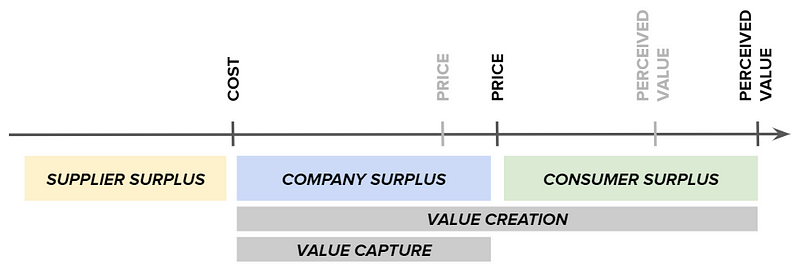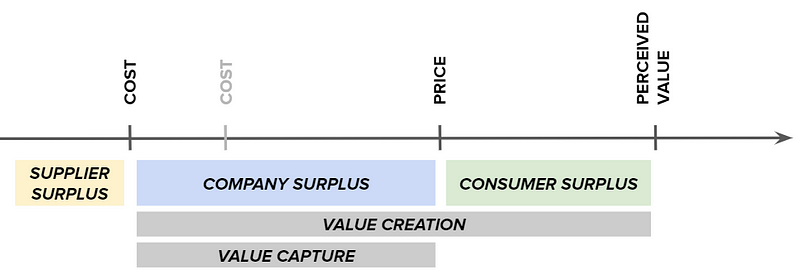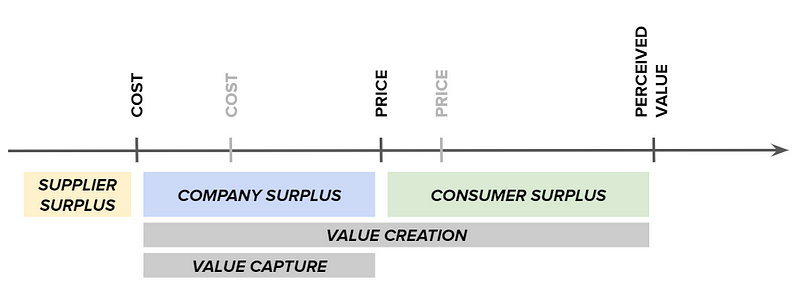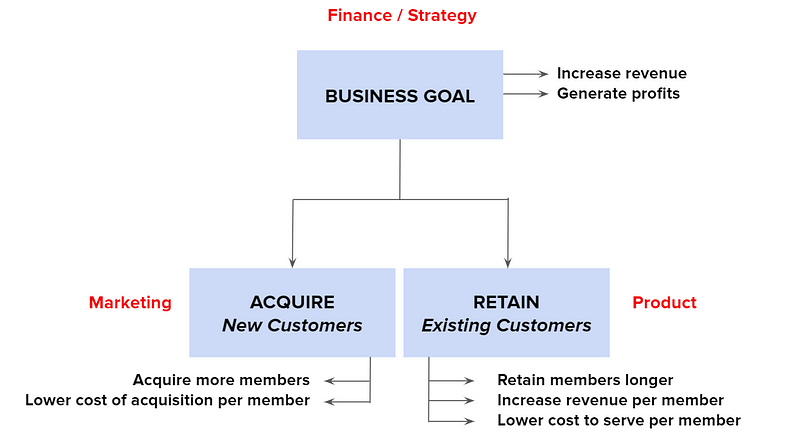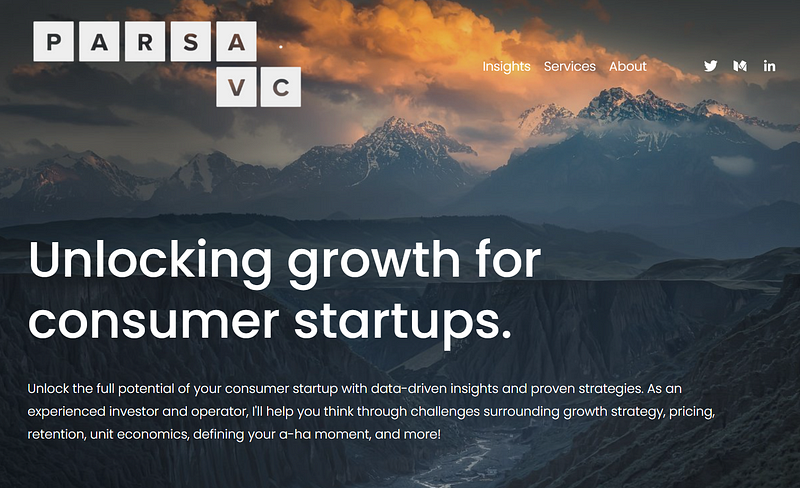The Intersection of Value: Achieving Optimal Product-Market-Price Fit for Business Growth
Achieving “Product-Market-Price” fit is critical to driving optimal business growth and creating & capturing value.
I offer consulting services and can help you think through challenges surrounding growth strategy, pricing, retention, unit economics, and more. Learn more.
Product-Market fit is met when a product addresses and solves a pain point for a customer segment. I previously wrote a blog post going deep into concepts around product-market fit. Product-market fit, on its own, however, misses a critical component that is paramount to building a functioning business: price.
Understand Product-Market-Price (PMP) Fit
Let’s take a simple example to illustrate why price should always be a part of the equation. In 2010, Uber launched with a really simple and strong value proposition: one-click hailing, fast response times, high tech solution. Strong product-market fit, right? Sure, but let’s take this a step further with some more context:
A ride downtown costs $5: An individual who wants a reliable ride from point A to point B would find this solution decently attractive. PMP Fit: High
A ride downtown costs $100: An individual might deem this to be too expensive. The narrative changes with price. PMP Fit: Low
Uber’s ability to create and capture value is dramatically influenced by price. So, with that, let’s dive in below on how to properly set pricing.
Pricing Strategies
There are a few common pricing strategies, identified below. Finding the ideal strategy depends on your company’s circumstances and target market dynamics.
Each of these approaches have pros and cons. My colleague at WHOOP, Sam Bauman, wrote a fantastic article that goes into detail on each specific strategy. It is worth noting that these strategies can co-exist as a product evolves. For example, Apple initially prices its products using a value-based approach, then switches to a skimming strategy to maximize profits.
The Principles of Pricing
Robert Dolan and John Gourville authored a fabulous paper on pricing strategy in 2005. They helped simplify pricing by breaking it down into a set of basic principles:
Cost: The amount it costs to product one unit
Perceived Value: The willingness to pay for one unit
Price: The price set to purchase one unit
Below is a simple illustration of these principles at work. The gap between cost and perceived value is considered as value creation. The gap between the price and cost is considered as value capture (company surplus or gross margins). The difference between the perceived value and the price is the consumer surplus or delight. Every consumer falls on a different point on the perceived value spectrum. It is imperative to understand your customer personas in detail and have various products and packaging strategies to meet the needs of each of these consumers.
Your customer needs to find that your price falls within their range of what’s acceptable, that being equal to or less than perceived value. Conversely, your ability to price is constrained by your costs if you want to capture any value. Pricing at perceived value is the price ceiling, maximizing company margins at the expense of consumer surplus. Pricing at cost is the theoretical price floor, maximizing consumer surplus at the expense of company margins. Your approach to pricing is influenced by a variety of factors, some within and some outside of your control. Stay tuned for a post on this in the coming weeks!
Let’s go through three profit enhancing tactics together and build on the above illustration to make things clear.
Raise Prices
One way to increase a company’s profit margins is to raise prices without changing anything else. This enables the company to capture a greater share of each transaction’s value at the expense of the consumer. Shopify recently increased its prices, but was able to do so with minimal backlash due to its pricing power in the market.
Sometimes, companies might be forced to increase their prices due to an increasing cost structure and lack of capital options. The higher cost structure is value destructive so in order to maintain its margins, a company must increase its prices as an offset. A recent example of a company that raised its prices due to higher costs was Peloton. This turned out to be a smart move in that it has enabled them stabilize their business. If they didn’t have strong pricing power, their price increase could have backfired.
Raise Willingness to Pay
Another way to drive increased profit margins is to increase the perceived value of your product and split the surplus between the company and consumer. This is much easier said than done, though. A recent example of a company that tried to execute this was Strava. They have very dedicated consumers, strong network effects, and a leading brand in the social fitness category. Warning though, even if you have surplus with your customers, price increases are tricky. Some members will often feel upset, especially in the current macro climate. A best practice is the be transparent about how and why you’re increasing prices.
Lower Costs
Finally, companies can drive higher profits by paying their suppliers less and lowering their cost structure. These companies are similarly creating more value and thus able to capture more value for themselves.
Companies that lower their cost structure could also choose to pass off all or some of these gains to their consumers by virtue of lower pricing. The benefit of this approach is that lower pricing can enable the company to open up to new markets of consumers. This approach follows the price-skimming strategy. Tesla and Apple commonly deploy this strategy to reach new market segments with their older generation products.
Determining Perceived Value (Willingness to Pay)
You might be asking how to actually determine these figures above. To calculate perceived value, there are a variety of different approaches. I’ll highlight my two favorite approaches below.
Conjoint Analysis
A conjoint analysis is a popular method of pricing research and is frequently used to understand willingness to pay for consumer goods. This type of survey maps out consumer preferences with a series of “would you rather” questions.
The best way to start is by breaking a product down into its components / attributes and then testing different combinations to identify user preferences.
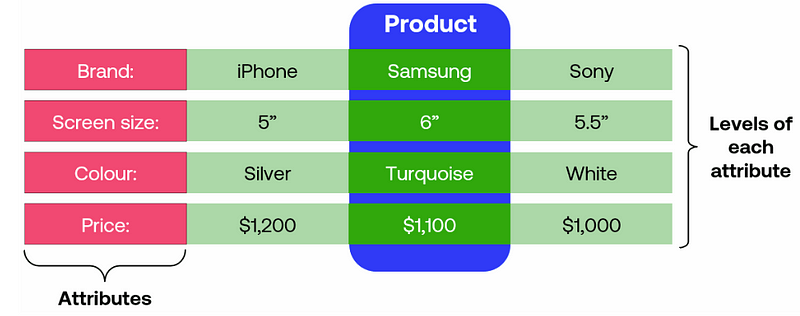
The power of the conjoint analysis is that it focuses on forcing members to choose between two alternatives. For example would you rather purchase a 6" Silver iPhone for $1,000 or a 5.5" White Sony for $1,000? At statistically significant scale, the survey results will illustrate “preference scores” towards a variety of attributes. This can help determine what attributes, including price, that members value.
Van Westendorp Analysis
A simpler version of getting to willingness to pay is through the Van Westendorp method. Survey respondents are asked four simple questions.
At what prices would you consider the product to be: too cheap, a bargain, starting to get expensive, too expensive?
Plotting the responses to these four questions helps illustrate the optimal price range as well as member price sensitivity.
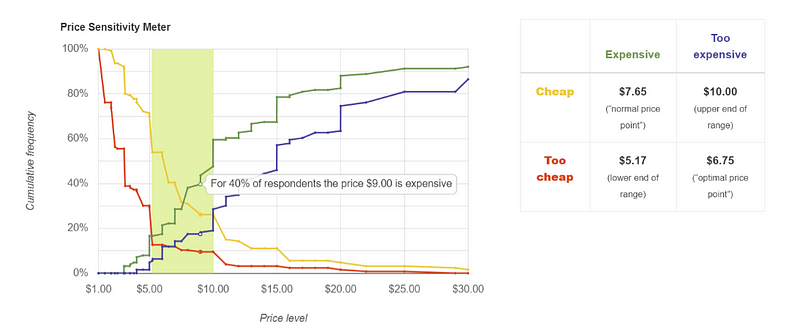
In the example above, the optimal price point is when the “too expensive” and “too cheap” lines intersect at $6.75. The range of acceptable prices is where “too cheap” and “expensive” intersect ($5.17) to where “cheap” and “too expensive” intersect ($10.00).
It is important to survey three groups:
Market panel: people who have not yet used your product
Current customers: people who are actively using your product
Churned customers: people who used but churned from your product
One of the beauties of the Van Westendorp method is that it visually illustrates pricing “break-points”. For example, you can see a large jump at $10, $15, and $20 of people who deem this product to be too expensive. There’s truth to the concept of “charm pricing”. Prices ending in 9, 99 or 95 make items appear cheaper than they really are. We read from left to right and are more likely to register the first number and make an immediate conclusion as to whether the price is justified.
Determining Cost
When referring to costs, we’re focused mainly on cost of goods sold. I have written previously on how to better understand your unit economics and cost structure. If you need a refresher, check out my prior post on the topic here. Generally, the main costs include raw materials, hosting costs, fulfillment costs, customer support costs, etc.
Once you understand costs and perceived value, you will have more clarity on the appropriate price level and strategy for your business.
Who is Responsible for Price?
Short answer, the whole company. Pricing is the most important and visible aspects of your strategy. The collective team (often led by product or finance) need to align on right pricing level and strategy to maximize revenue potential within customer expectations. The product team needs to then build an experience that delivers on these consumer expectations, to drive retention. The marketing needs to sell the product to the right consumer, driving an efficient acquisition model. The product then needs to be built in a scalable way, minimizing cost to serve.
It is no surprise that companies that maximize value creation operate in large markets, have strong leadership, a clear strategy, deep understanding of customer needs, a strong execution muscle, and tight cohesion between teams. They are often rewarded with growth and a clear path to sustainable cash generation, the ultimate business goal.
Special thanks to my WHOOP Strategic Finance counter-parts Sam Bauman and Amit Bhatt for their contributions to this post. Also big thanks to various of my colleagues who helped us execute recent pricing changes at WHOOP: Nate Giacalone, Ben Katz, Matt Luizzi, John Sullivan, Briain Curtin, Aoife O’Driscoll, Radha Bennett, Carly Ward, and so many more. Major team effort!
Interested in going deeper? I offer consulting services and can help you think through challenges surrounding growth strategy, pricing, retention, unit economics, defining your a-ha moment, and more. Learn more.
